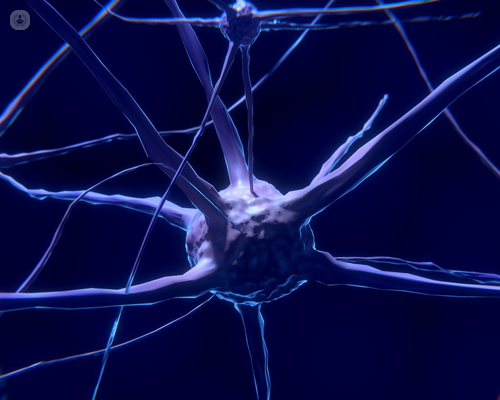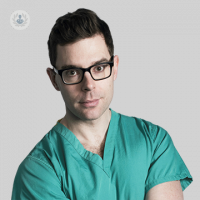Spinal cord stimulator therapy: A light at the end of the tunnel for chronic pain
Written in association with:A spinal cord stimulator (SCS) can be an effective type of therapy for chronic pain, particularly for chronic nerve-related pain that hasn’t responded to treatment.. It involves a thorough assessment process and a trial of therapy first: not all people with chronic pain will benefit. Potential benefits include reducing pain by more than half in most people, reducing medications, sleep improvements and improving quality of life. Here to tell us all about this treatment is leading consultant neurosurgeon Mr Michael Hart.

What’s a spinal cord stimulator?
A spinal cord stimulator is a small device implanted via surgery, and uses electrical current to ‘dampen down’ pain signals travelling from the spine to the brain. In certain people with chronic pain, it can be a highly effective therapy for improving symptoms and quality of life. Other advantages are that it’s minimally invasive, fully reversible and drug-free.
How does it work?
Physiologically, pain derives from nerve fibre so the logical way to stop pain is to target the source of the pain. To give you an example, at one stage or another we’ve all sustained a minor injury such as a bumped elbow or knee. We’re taught from childhood that simply rubbing the affected area helps the pain settle down. This same effect happens in the spinal cord. Stimulating this through an SCS device can be a really powerful method of treatment. The concept of using electrical current (neuromodulation) to manage pain was first considered in the 1960s. Shortly afterwards, the first SCS devices were developed that used electrical current to mimic this effect and cause a light and pleasant tingling sensation.
By the 1990s, there were specific percutaneous leads which meant that applying the electric current to the spine (spinal cord stimulation) could be used to provide drug-free pain relief quickly and effectively. Newer SCS devices now use different stimulation patterns to provide pain relief in other ways and without the associated tingling. The evidence in the clinical literature grew substantially and now it’s accepted medical practice to provide this therapy for a variety of chronic pain conditions.
What do you mean by chronic pain?
An estimated 28 million or one in five adults in the UK are currently living with chronic pain. Globally, the picture is around 1.5 billion, with one in ten developing chronic pain each year. Chronic pain has a detrimental impact on the lives of people suffering from it, often stopping them from leading the full and active lives they deserve.
Nerve signals are being passed from the body to the brain constantly. This is helpful because it tells us when we are hurt or injured. However, if nerves become injured, they can send pain signals to the brain even if an injury is not occurring. This is unhelpful and leads to chronic or long-term nerve (neuropathic) pain. This can lead to problems in day-to-day life such as sleeping and working, as well as impacting our hobbies. Related problems can then develop including mood disturbance, weight gain, de-conditioning (due to a lack of exercise), and reliance on strong painkillers (such as opiates).
How do I know if a spinal cord stimulator will work for me?
We now have a good idea about who will benefit, and who will not. Firstly, pain must be severe and impact upon quality of life. Not all types of pain respond well to SCS, therefore it’s important to establish the underlying diagnosis too. Typical types of pain that can respond including neuropathic pain, complex regional pain syndrome (CRPS), persistent spinal pain (PSP, also known as failed back surgery syndrome or FBSS), cancer pain and painful peripheral neuropathy (e.g. pain that’s due to diabetes). Often pain that’s related to nerve malfunction, known as neuropathic pain, responds best. Prior to getting to a spinal cord stimulator people have often had decompressive spinal surgery or neurosurgery, but this isn’t mandatory.
To get the best outcome, a proper assessment process is required to best understand the particular type of pain and its effectiveness on an individual. Additionally, optimising medical therapy participation in a pain management programme is also likely to make the outcome better overall. There are other positive indicators too, as well as some negative indicators that suggest the therapy won’t work. We have a detailed referral process that can aid understanding who might be a suitable candidate or not.
Other parts of the assessment process typically include an up-to-date MRI scan of the whole spine, a psychological assessment and a nurse education visit. Following this we make a team recommendation, and usually follow up with a trial of the therapy.
Can you try SCS before you buy?
The final step often involves a trial of the therapy. This is a brief day case operation where the wires that deliver the therapy are placed through the skin (like a cannula or ‘drip’), then connected to a battery that you wear around your waist for one to two weeks. These wires can then simply be removed in clinic as an out-patient. Subsequently, a discussion can be had about the potential benefit of therapy that was appreciated during the trial. Only at this point, once all the assessments have been performed, will we know whether it’s recommended to proceed with the whole device or not. This is also a great opportunity to ‘test drive’ the spinal cord stimulation therapy and find out if it’s right for you.
What effect can I expect?
It’s important to remember a spinal cord stimulator isn’t a cure or a treatment for the underlying cause. Typically, a good accepted outcome is a 50 per cent reduction of pain. More importantly, it’s hoped that this reduction in pain can, in turn, help improve individuals quality of life, for example being able more active, perhaps returning to work, better sleep and getting back to enjoying your favourite hobbies. Another important and realistic goal is being able to reduce medications. Relief from long-term opioid therapy is particularly worthwhile.
What is the surgery like?
Surgery is usually performed under general anaesthetic or sedation. It can be a day case procedure although sometimes an overnight stay is required. There will usually be two incisions; one for the wires and one for the battery. Pain after the procedure is usually mild and can be managed with over-the-counter medications. Overall, SCS surgery is minimally invasive, and other than scarring, should not cause any permanent changes to spinal anatomy (unlike standard decompressive spinal surgery and neurosurgery).
What happens after surgery?
After surgery, it’s advised you should go home, fully recover and let everything heal. During this time, the device is turned off. After a few weeks we start to programme the device at clinic. This can take some time and it requires a few follow-up visits to tune it exactly to an individual. There’s also a requirement to commit to routine follow-up and maintenance. For example, the battery may become depleted (often after more than 10 years), which would require a brief procedure under local anaesthetic to install a replacement.
So, what’s life like with a spinal cord stimulator?
What we aim for with the device is to ‘set it and forget it.’ That is, once it’s implanted and programmed to give effective pain relief, we would like people to carry on living and enjoying their lives as much as possible.
Nevertheless, there are a few key things to know about living with a device, for example how to get through airport security. We can cover all of this as part of the pre-operative patient education visit where there’s a chance to see a real model of an SCS device. Rest assured that normal activities like driving are fine (once fully recovered from surgery), and it’s possible to have all the normal MRI scans too (albeit with a few additional checks to make sure the device is ok too).
This sounds great. But are there any risks I should be aware of?
Like any surgical procedure, there are risks, even if everything is done carefully by an experienced team. However, it’s important to remember that risks are rare, so, for example in every 100 operations, only three to four people have a problem. All potential risks and complications will be covered in detail as part of a thorough pre-operative consent process, backed up by a detailed patient information pack. Notably, any side effects from stimulation can be stopped by either adjusting or turning off the device. In this regard, the treatment is fully reversible.
Before I decide, are there any alternatives?
Yes, of course. The main thing to note is pursuing spinal cord stimulation is a choice. If you don’t feel it is right for you, then there is no pressure to pursue it further.
It’s important to take a holistic approach when managing long-term pain. Treatment with SCS should be seen as a useful adjunct in people who otherwise have trialled potential non-operative therapy first. To maximise benefit, it’s usually best to have seen a pain specialist and undergone a pain management programme first. In some cases, decompressive spinal neurosurgery may be preferrable, whereas in others, spinal injections may be better. Regardless of the treatment, a healthy lifestyle with plenty of exercise is strongly recommended.
How can I find out more about spinal cord stimulator (SCS) treatment?
Fortunately, there are multiple resources out there. We have an active blog on Instagram, led by our pain nurse. There are also detailed leaflets from British Pain Society on Spinal cord stimulators.
Always be sure to talk to your neurosurgeon about everything. Outcomes are best when one gets feedback on their individual situation, and treatment goals become more realistic. No two people are alike and therefore the outcome (and indeed, suitability for a spinal cord stimulator) will not necessarily be the same as some else.
Education is the key!
Are you considering spinal cord stimulator therapy for chronic pain? Arrange a consultation with Mr Hart via his Top Doctors profile.


